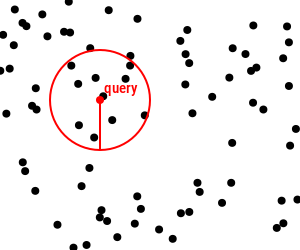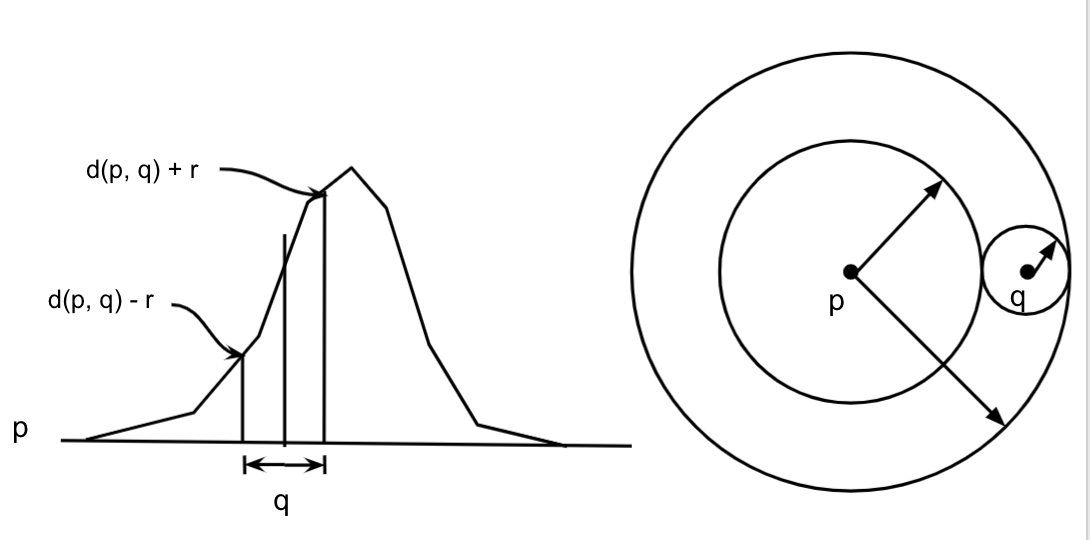Similarity search¶
- Lookup a large collection for similar objects to a given query
- It is a general framework for searching in data collections
- The core idea is to represent the collection in a metric space
- Each object in a dataset is a valid object in the metric space
- There exists a distance function $d$ that captures the similarity notion (defined among any two valid pairs of objects)
The metric space model¶
Useful whenever data lacks a linear or natural order, but there is a notion of similarity.
- Text
- Images
- Cloud points
Vector spaces, strings, sets, graphs, collections, etc.
Searching problem¶
Given a metric space $(U, d)$ and a database $S \subseteq U$, create a data structure on $S$ to solve efficiently queries $q \in U$.
- Range queries: given the query object $q$ and the radius $r$, find those items in the dataset $S$ such that $\{u \mid d(q, u) \leq r, u \in S\}$
- $k$ nearest neighbor queries: retrieve the $k$ nearest items in $S$ to $q$, i.e., $knn(q, S) = \{ u \mid d(q, u) \leq r^*, u \in S\}$ where $r^*$ is the distance to the $k$-th nearest item to $q$ in $S$, $|knn(q, S)| = k$ and ties are solved randomly. we will focus in this operation

The distance function must be a metric, i.e., for any $u,v,w \in U$:
- simmetry: $d(u,v) = d(v, u)$
- positivity: $d(u,v) > 0$
- equivalence: $d(u, v) = 0 \iff u \equiv v$
- triangle inequality: $$|d(u, v) - d(v, w)| \leq d(u, w) \leq d(u, v) + d(v, w)$$

Pros¶
- Well known mathematical framework
- Many approaches to model complex data extract features or represent some kind of relations, i.e., often create vectors, sequences, or graphs.
- The metric search paradigm is quite general and powerful, i.e., it has been used to represent a myriad of problems:
- Textual and multimedia information retrieval.
- Speedup solution of Motion planning (RRT).
- Speed up learning algorithms (clustering).
- There exist several algorithms and structures (indexes) that are used in practice.
Cons¶
- It requires a metric function $d$ to work
- There are many well-known metrics, e.g., https://github.com/JuliaStats/Distances.jl, but a particular problem may need an additional kernel function to work (efficiently/correctly)
- It ignores object structure, and so, it cannot speed up based on the structure, e.g., ignores the use of vector coordinates.
- Highly sensitive to the internal dimensionality of the dataset

Traditional approaches¶
- Pivot tables: AESA, LAESA, SSS, BNC
- Sparse pivot tables: KVP, MANNI, EPT
- Compact partitioning indexes: LC (and its variants), PMI
- Others: Trees partitioning datasets like VPT, MVPT, SAT, DiSAT, BKT, metric tree, ball tree, metric file, etc.
There is a lot of work under these schemes.

Another issue with traditional approaches comes with large datasets and high dimensions:
- Pivot tables use a lot of extra memory q, tending to be quadratic.
- Compact partitioning indexes need linear memory but require quadratic construction time.
In any case, as the dimension increase, the discarding power of any exact metric index is heavily degraded; the approach is cursed.
My related work on exact similarity search¶
- Tellez E.S., Chavez E., Figueroa K. (2012). Polyphasic Metric Index: Reaching the Practical Limits of Proximity Searching. In: Navarro G., Pestov V. (eds) Similarity Search and Applications. SISAP 2012. Lecture Notes in Computer Science, vol 7404. Springer, Berlin, Heidelberg.
- Tellez, E. S., Ruiz, G., & Chavez, E. (2016). Singleton indexes for nearest neighbor search. Information Systems, 60, 50-68.
- Ruiz, G., Chavez, E., Ruiz, U., & Tellez, E. S. (2019). Extreme pivots: a pivot selection strategy for faster metric search. Knowledge and Information Systems, 1-34.
Resources:¶
- Natix (from my github): https://github.com/sadit/natix
- SISAP similarity search library: https://www.sisap.org/metricspaceslibrary.html
- SISAP: https://www.sisap.org/